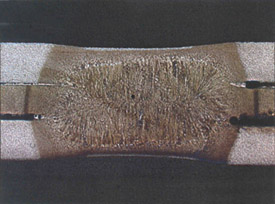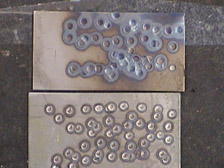|
 Boron
Steel Boron
Steel
Much has been written about the new range of Advanced High Strength
Steel being used in Modern car design.
USIBOR-BTR-Boron are all the same grade of steel, just with a different
name, depending which country it comes from. It is very strong but
light in weight.
This steel will be found in the new Volvo XC90, Saab, BMW E60, Porsche
Cayenne, VW Toureg and many other cars.
In general it is used to provide extra strength in the sill area,
B Post, chassis areas, rear cross members and as roll over bars.
It is difficult to repair and certain repair methods should only
be employed.
However, whichever
new car you are working with now or in the future it is very likely
that you will find some Boron steel somewhere.
Not only are
there are many other new steels all with differing strengths, there
are also many new coatings which the steel has been treated with.
Coatings such as Zinc, Bonazinc, Granocoating, Aluminated sheet
metals etc. This all adds to the confusion over the steels as well
as the difficulty in repair.
Spotwelding
repairs
The High Strength Steel ZSTE 340 being used on all European cars
today is lighter than normal steel, on account of the alloys that
have been added during manufacture. It is designed to be light and
very strong but it must not tear or fold easily in an accident.
 To
spot weld this steel correctly there are three very important aspects
that have to be present. To
spot weld this steel correctly there are three very important aspects
that have to be present.
a. Electrode force
b. Correct power
c. Correct tip (size and shape)
Electrode
Force
The electrode force must be above 300daN (decanewtons) which is
approx 300kgs of force. This is to ensure that during the welding
process the metal is kept firmly in place and will fuse correctly
at the spot. With weaker electrode force the metal may explode (spark
fiercely) and leave a porous, weak weld that would definitely not
hold up in an accident.
Power
The welding power needed to fuse the high strength steel correctly
must be at least 8,000 amps (rms). This means that the average power
for the whole weld process must be 8,000 amps and not just for a
momentary spike of power at some time during the weld. The resultant
spot must have a very small burn mark around it so that the strength
of the metal remains constant.
With lower power or longer burn times the welds will have a bigger
burn mark and the integrity of the weld will be compromised.
 Correct
Tip Correct
Tip
It is important that the tips should be flat and not domed or pointed.
The essence of the profile is to give a flat factory shaped weld
that does not push into the surface of the steel, which would in
turn weaken the metal at the spot.
All conventional welders and some of the new inverter welders fall
down on the first point, as their electrode force would not reach
200daN. All conventional welders and some inverter welders also
do not reach 8,000amps. All the existing spot welders do not have
a combination of the correct tips or burn time (except the InvertaSpot).
Problems
This means that every day more and more cars are entering the market
place which inevitably will need repair. However, most are not being
repaired correctly because the incorrect tools are being used to
repair them.
 Bodyshops
that do not have the correct equipment are actually welding the
cars together, thinking they have achieved a satisfactory weld,
in fact, if the welds were tested they would be shown to be weak
or have insufficient nugget size. See for yourself on a car that
has been repaired, how many welds have failed when the same car
is in a subsequent accident. Bodyshops
that do not have the correct equipment are actually welding the
cars together, thinking they have achieved a satisfactory weld,
in fact, if the welds were tested they would be shown to be weak
or have insufficient nugget size. See for yourself on a car that
has been repaired, how many welds have failed when the same car
is in a subsequent accident.
The car manufacturers
without exception are all looking at inverter welders as a means
to welding this new steel. It is the process that is used in their
factories, so it is logical that the same process should be now
used in the bodyshops.
For more information and to register for updates by email, please
click here.
Main
Links:
|
Spot
Welding Links:
|
TOP
OF PAGE
|


 Boron
Steel
Boron
Steel To
spot weld this steel correctly there are three very important aspects
that have to be present.
To
spot weld this steel correctly there are three very important aspects
that have to be present. Correct
Tip
Correct
Tip Bodyshops
that do not have the correct equipment are actually welding the
cars together, thinking they have achieved a satisfactory weld,
in fact, if the welds were tested they would be shown to be weak
or have insufficient nugget size. See for yourself on a car that
has been repaired, how many welds have failed when the same car
is in a subsequent accident.
Bodyshops
that do not have the correct equipment are actually welding the
cars together, thinking they have achieved a satisfactory weld,
in fact, if the welds were tested they would be shown to be weak
or have insufficient nugget size. See for yourself on a car that
has been repaired, how many welds have failed when the same car
is in a subsequent accident.